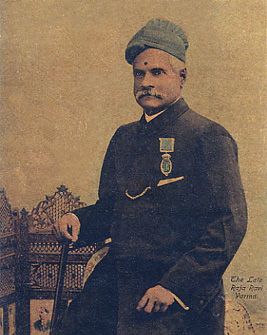
Table of Contents
Introduction
A brief introduction to the life of Raja Ravi Varma
In this blog we will delve in to the world of Raja Ravi Varma paintings, where each canvas tells a unique story from the heart of Indian culture. Imagine that you are being transported back to the 19th century, an era that was marked by a cultural and artistic renaissance in India. It was during this time that Raja Ravi Varma, a great personality in the Indian art scene, emerged. His artistry left a profound mark on the canvas of Indian art history, revolutionizing the way stories were told through paintings
Born in 1848 in the princely state of Travancore, now Kerala, Ravi Varma was more than just an artist – he was a visionary. His extraordinary talent lay in seamlessly weaving the rich tapestry of Indian mythology with the elegance of European artistic styles, thus creating a mesmerizing visual symphony. The vivid stories of Indian epics and puranas, once only part of oral tradition and classical dance, found a new and vibrant expression on canvas through Varma’s ingenious brushwork.
Raja Ravi Varma’s impact on Indian art
What set Varma apart was his unique ability to make these traditional Indian themes resonate with a wider audience. He was like a bridge between two worlds: the ancient and the modern, the East and the West. By adopting European techniques, such as oil painting and realistic portrayal, he brought a fresh perspective to Indian art. His paintings were not just mere representations; they were a fusion of the ethereal charm of Indian folklore with the realism and finesse of European art.
Through his art, Varma did something extraordinary. He took the stories that were etched in the hearts of the Indian people – tales of gods, goddesses, and heroes – and gave them a new and familiar form. This was revolutionary. He made art that was accessible, art that spoke to people, art that told stories.
In this blog, we will explore Raja Ravi Varma’s masterpieces. We’ll see how each painting is not just a visual treat but a narrative that tells India’s story of its rich culture, heritage, and traditions. Get ready to be mesmerized by the art of a man who didn’t just paint pictures; he painted India’s soul.
Uniqueness in Raja Ravi Varma Paintings
Following our introduction to the remarkable Raja Ravi Varma, let’s dive into what really set him apart – his unique artistic style. This guy was a true pioneer, blending the best of two worlds in a way that was never seen before in Indian art.
Fusion of Indian traditions and European techniques
First off, let’s talk about his use of oil paints. Now, this might not sound like a big deal today, but back in Varma’s time, this was groundbreaking in India. Oil painting was predominantly a European thing. Varma, with his adventurous spirit, decided to bring this technique to Indian art. And boy, did it make a difference! The richness of colors, the depth, the texture – all this brought a lifelike quality to his paintings that was pretty much unheard of in Indian art circles back then.
But Varma didn’t just stop at adopting a new medium. He married this European technique with the aesthetic sensibilities of Indian art. Imagine this: the detailed storytelling of Indian traditions, with its rich tapestry of gods, goddesses, and mythological tales, all coming to life with the realism and vibrancy of oil paints. It was like he was giving a new lease of life to these ancient stories, making them more relatable and real to the viewer.
What’s truly fascinating is how Varma balanced this act. On one hand, he had the realism and detail-oriented nature of European art – the kind that makes you feel like you could step right into the painting. On the other hand, he stayed true to the Indian ethos, with its symbolic imagery and storytelling tradition. This blend wasn’t just about mixing two styles; it was about creating a whole new visual language, one that resonated with the Indian soul while embracing modernity.
How it revolutionized Indian art
Through his art, Varma made Indian themes more accessible to the common people. His paintings weren’t confined to palaces or temples; they reached the homes of ordinary folks, thanks to the lithographic reproductions of his work. This way, he didn’t just revolutionize art; he democratized it, making it a thing of the people.
In essence, Raja Ravi Varma’s style was not just a fusion of East and West. It was a dialogue between the two, a celebration of Indian narratives in the lexicon of European realism. He didn’t just paint; he connected worlds, and in doing so, he created a legacy that would inspire generations to come.
Top 10 Paintings of Raja Ravi Varma
Moving on in our exploration of Raja Ravi Varma’s masterpieces, let’s delve into his top 10 paintings, each a testament to his extraordinary talent.
1. Shakuntala, 1898
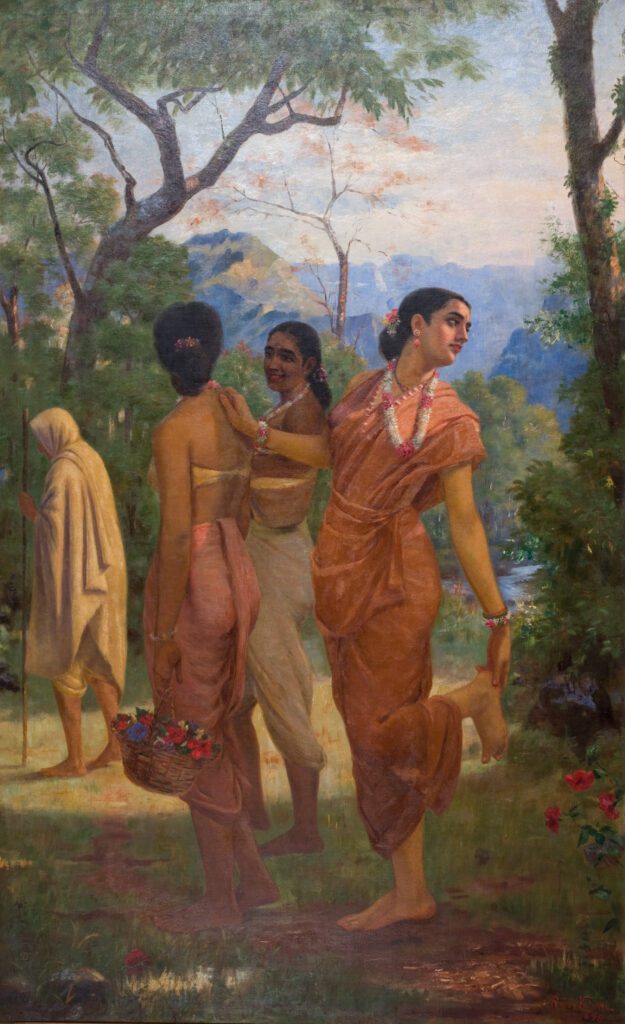
“Shakuntala” is an enchanting portrayal of the titular character from the Indian epic Mahabharata. Varma captures Shakuntala in a moment of introspection, lost in thoughts of her beloved Dushyanta.
Shakuntala seizes the opportunity to look at her lover Dushyanta once more. As she heads back to the hermitage with her friends, Anasuya and Priyamvada, she pretends to have been pricked by a thorn. She look back at her lover, feigning to remove a thorn from her foot.
The realism here is striking – her expressive eyes, the graceful posture, and the natural surroundings all bring to life the character’s inner turmoil and longing. Varma’s use of vibrant colors and detailed realism, influenced by European art, makes Shakuntala not just a mythological figure but a relatable, living person.
2. Lady in Moonlight, 1889

In “Lady in Moonlight,” Varma showcases his exceptional skill in portraying feminine beauty and serenity. The painting is bathed in a soft, ethereal glow, highlighting the lady’s delicate features. The use of light and shadow creates a tranquil, almost mystical atmosphere, with the moonlight accentuating the subject’s elegance and poise. This piece is a perfect example of Varma’s ability to evoke mood and emotion through his mastery of lighting.
3. Arjuna and Subhadra, 1890
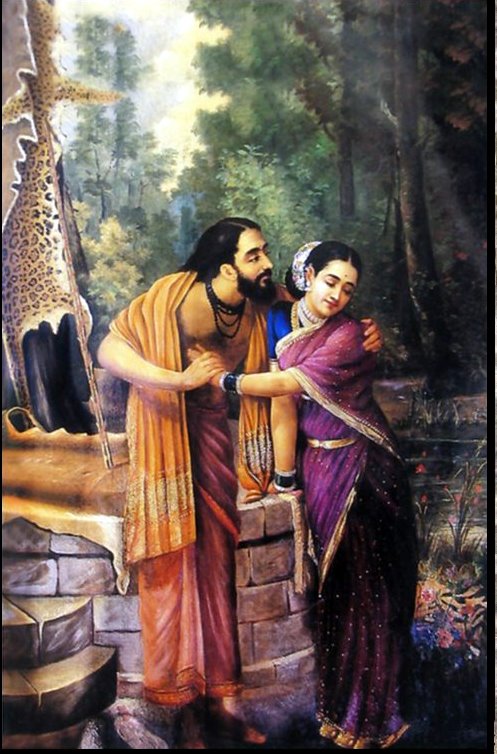
Arjuna and Subhadra” by Raja Ravi Varma is a captivating painting that depicts the elopement of Arjuna with Krishna’s sister, Subhadra, during his exile. Varma’s vibrant colors and lively composition bring this mythological story to life. The painting captures not just their elopement but also the eventual acceptance of their union by Krishna and others. This moment leads to the birth of their son, Abhimanyu, a significant figure in the Mahabharata. Varma’s skillful portrayal of emotions and detailed attire in the painting makes it a fascinating narrative piece.
4. The Milkmaid, 1904
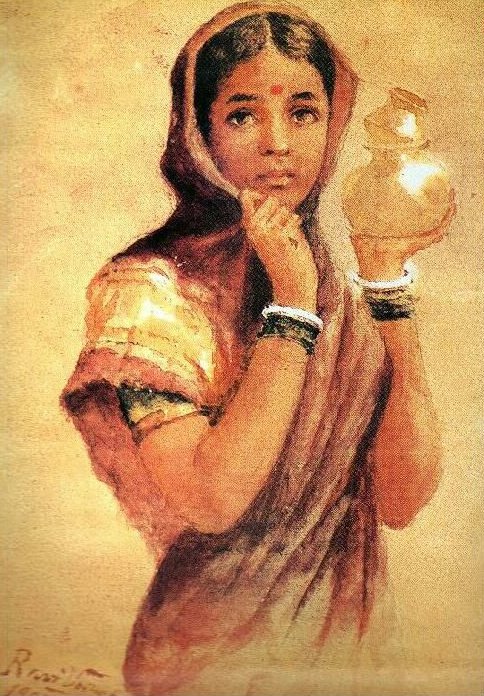
“The Milkmaid” is a celebration of the ordinary, showcasing Varma’s ability to find beauty in everyday life. The painting features a simple scene of a milkmaid at work, yet Varma renders it with such dignity and grace. The detailing in her attire and the serene expression on her face highlight the nobility in daily chores, a theme often overlooked in art.
5. Damayanti Talking to a Swan
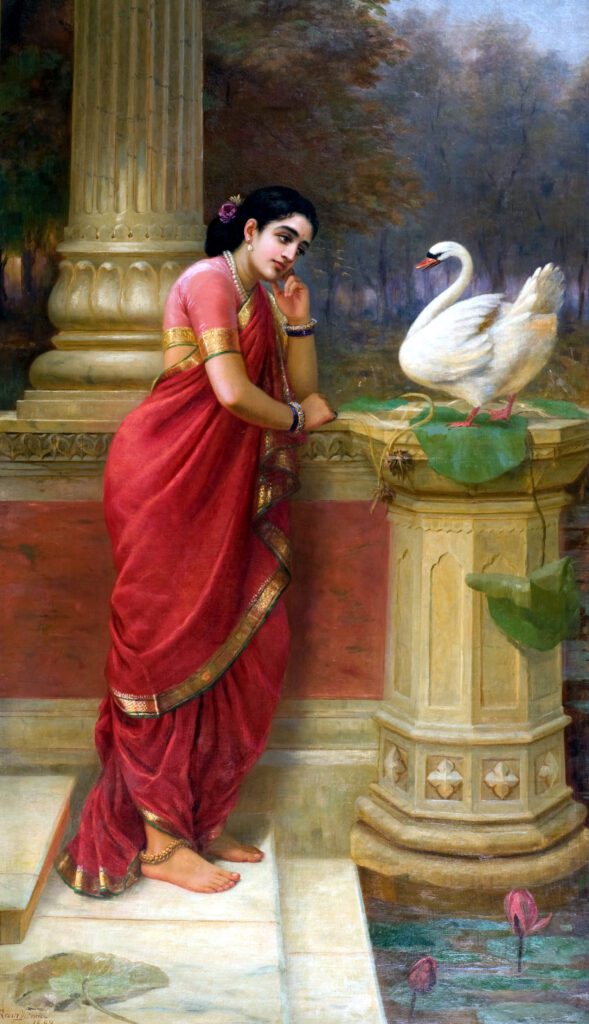
In “Damayanti Talking to a Swan,” Varma once again turns to the Mahabharata. The painting depicts Damayanti, a princess, in conversation with a swan, who is a messenger from her lover, Nala. Varma’s portrayal of this mythical interaction is both serene and full of life, showcasing his ability to blend human emotion with the natural world in a harmonious and engaging manner.
6. Maharashtrian Lady

“Maharashtrian Lady” is a tribute to the rich cultural diversity of India. Varma’s focus on the details of her traditional attire, from the intricacy of her saree to the fineness of her jewelry, highlights the elegance and dignity of Indian women. The painting is a celebration of Indian heritage and Varma’s dedication to representing it with authenticity.
7. Galaxy of Musicians
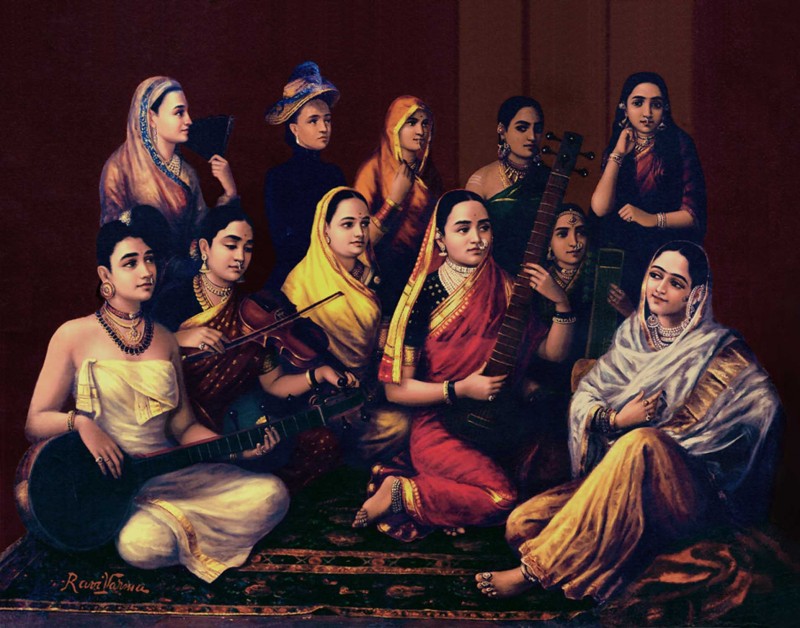
“Galaxy of Musicians” by Raja Ravi Varma is a fascinating portrayal of India’s diverse musical heritage. In this vibrant painting, Varma brings together musicians from different parts of India, each with their traditional instruments. There’s a veena player from South India, exuding the classical charm of Carnatic music. A musician with a sitar represents the rich heritage of North Indian classical music. From the East, a woman holds a flute, reminiscent of the pastoral landscapes of Bengal. A tabla, synonymous with North Indian rhythm, adds to the ensemble, while a pakhawaj from Central India anchors the rhythmic foundation. The painting also features regional instruments like the Punjab’s sarangi, adding a poignant melody to the mix. This masterpiece is a visual symphony, celebrating the unity and diversity of India’s musical traditions.
8. Vishwamitra and Menaka
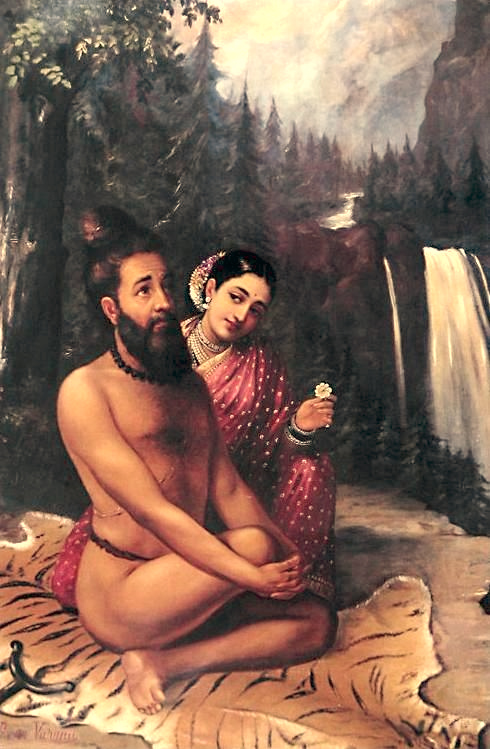
“Vishwamitra and Menaka” brings to life another mythological story. Varma’s dramatic portrayal of these characters, with their expressive faces and the dynamic setting, captures the essence of the tale. The vivid colors and the intricate detailing in their attire and surroundings make this painting a visual feast, telling a story that’s as compelling as any written narrative.
9. Nair Lady Adorning Her Hair

This painting captures a simple, yet intimate moment in the life of a Nair lady. Varma’s focus on everyday routines, like a woman adorning her hair, and his ability to find beauty and grace in such moments, is remarkable. The detailing in her attire and the peaceful expression on her face turn a mundane activity into a moment of quiet elegance.
10. There Comes Papa

“There Comes Papa” is a touching portrayal by Raja Ravi Varma, capturing a tender family moment. This painting features Varma’s daughter and her child, with a sense of excitement and anticipation beautifully depicted. The child, with eyes bright and finger pointed outward, seems to be eagerly awaiting someone’s arrival, likely the father. Adding to this familial scene is a pet dog, attentively looking in the same direction, enhancing the painting’s homely and affectionate atmosphere. Varma’s ability to capture such intimate, everyday moments adds a personal touch to his work, making this painting a heartfelt representation of family life.
Each of these paintings is a window into Varma’s world – a world where myth, emotion, and daily life are rendered with equal finesse and depth. Through these works, Varma didn’t just capture images; he captured the essence of India’s rich cultural and mythological heritage.
Raja Ravi Varma’s Legacy
As we continue our journey through the art of Raja Ravi Varma, it’s crucial to understand the lasting impact he left on Indian art and culture. Varma wasn’t just an artist; he was a visionary whose influence went far beyond his own time.
Influence on later artists and popular culture
Varma’s approach to art was revolutionary. He brought a whole new perspective to Indian art by infusing European techniques with traditional Indian themes. This blend of styles opened up new possibilities for Indian artists, breaking the confines of traditional methods and inspiring a more versatile and expressive form of art. Future generations of artists looked up to Varma not just for his technique, but for his boldness in experimenting and innovating.
One of the most significant aspects of Varma’s legacy is how his paintings became a part of India’s cultural heritage. His works did something extraordinary – they made the rich tapestry of Indian mythology and history accessible to the common man. The characters from Indian epics and legends, once limited to temple carvings and oral tales, found a new home in Varma’s canvases. His paintings brought these stories into the living rooms of the Indian populace, bridging the gap between the sacred and the everyday.
Varma’s influence extended beyond the art world into the realm of popular culture. His depiction of gods and goddesses in human form had a profound impact on how these deities were visualized in later cultural expressions, including in movies, literature, and even in calendar art. The iconic images of deities like Saraswati and Lakshmi, as we know them today, are heavily influenced by Varma’s portrayal.
Furthermore, Varma’s work played a critical role in shaping the narrative of Indian nationalism during the pre-independence era. His paintings evoked a sense of pride and cultural identity among Indians, serving as a visual representation of India’s rich heritage and contributing to the burgeoning nationalistic spirit.
Lastly, Raja Ravi Varma’s legacy is not just about what he created but how he created it. His use of lithography made art accessible and affordable, democratizing art in an unprecedented way. This not only broadened the audience for his work but also set a precedent for art dissemination in India.
Raja Ravi Varma’s legacy is etched in the annals of Indian art history. His visionary approach, his bridging of two different art worlds, and his democratization of art continue to inspire and influence artists and art enthusiasts alike, keeping the flame of Indian art and culture burning bright.
Conclusion
As we wrap up our exploration of Raja Ravi Varma’s life and art, it’s clear that his contributions to Indian art are monumental. Varma was not just an artist; he was a storyteller, a pioneer, and a cultural icon. His unique ability to blend European techniques with traditional Indian themes created a new language in art that was both innovative and deeply rooted in India’s rich cultural heritage.
Varma’s paintings are more than just visual masterpieces; they are narratives that continue to speak to us, connecting us with the myths, legends, and everyday stories of India. His portrayal of characters from Indian epics, his vivid depiction of simple yet profound moments in life, and his skillful fusion of realism and tradition have left an indelible mark on the canvas of Indian art.
Today, Varma’s legacy lives on, not just in galleries and museums, but in the hearts and minds of people. His art transcends time, inspiring new generations of artists and art lovers. It serves as a bridge between the past and the present, reminding us of the rich tapestry of stories and traditions that form the fabric of Indian culture.
In a world where art and culture are constantly evolving, Raja Ravi Varma’s work stands as a testament to the enduring beauty and relevance of India’s artistic heritage. His legacy is a celebration of Indian art, a tribute to its history, and a source of inspiration for the future
FAQs
Who was Raja Ravi Varma?
Raja Ravi Varma was a renowned Indian artist famous for his unique approach to art. He masterfully combined European painting techniques with traditional Indian themes, creating a fusion that was groundbreaking in the Indian art scene.
Why are Raja Ravi Varma’s paintings significant?
Varma’s paintings are significant because they brought about a revolution in Indian art. By telling India’s story through a unique blend of European realism and Indian themes, he created artworks that were not only visually stunning but also culturally resonant.
What’s special about Raja Ravi Varma’s style?
The special thing about Varma’s style lies in his fusion of Indian tradition with European realism. This blend allowed him to create paintings that were deeply rooted in Indian culture while also being accessible and relatable due to their realistic portrayal.
Can I see Raja Ravi Varma’s paintings in person?
Can I see Raja Ravi Varma’s paintings in person?
Absolutely! Varma’s paintings are displayed in several museums and galleries across India. These exhibitions offer a wonderful opportunity to experience the beauty and depth of his work firsthand.
Can I see Raja Ravi Varma’s paintings in person?
Absolutely! Varma’s paintings are displayed in several museums and galleries across India. These exhibitions offer a wonderful opportunity to experience the beauty and depth of his work firsthand.
Did Raja Ravi Varma influence modern art?
Yes, Raja Ravi Varma had a significant impact on modern art. His influence is evident in various forms of Indian art and culture, inspiring generations of artists and continuing to shape the artistic landscape in India
